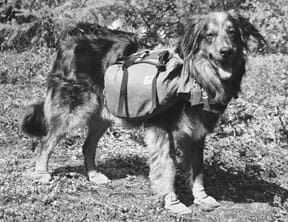“Is he something special, or just a mutt?” the man asked, as I passed him on the trail. Trigger, my 65-pound Australian Shepherd mix stood beside me with tail wagging, ready, as always, to meet this inquisitive stranger with the blunt question of parentage.

As one of the first people to hike in a national park with a service dog, I was very aware that Trigger and I had the responsibility to set a good example and to educate people about service dogs in national parks. Often when we stepped off the trail for a break or to let people pass, we got questions and I always took the time to answer them as accurately as possible. A lot of questions were about service dogs:
• What kind of service does he perform? (This, as he stands there wearing a pack!)
• Did he go to service dog school?
• Where do you get a pack dog?
While many dogs are trained by professionals and there are schools for the most common functions that dogs perform (such as guide and sound alert), many more dogs are trained by owners to perform the services necessary to meet their own specific needs. When I adopted Trigger I didn’t know he was to become my service/pack dog. But as our relationship developed and his training progressed, I also learned that I qualified under the Americans With Disabilities Act to declare him as my service/pack dog. This made it possible for me to take him into national parks and other places where dogs as pets are not allowed.
Defining Disabled
If you hike with a service dog, one personal question that you should be prepared to deal with is obvious: Why do you need a service dog? The details and nature of your response may depend on who is asking and why.
Many people do not understand how an individual can hike five or six miles over mountainous terrain and be disabled. When I meet people in high mountain camps or on the trail, I tell them about the ADA, which mandates a much more user-friendly (though relatively untested) definition of disability than that of the federal government for a Social Security disability grant. The ADA uses the terms “restriction,” “limitation,” and “impairment” all interchangeably with the word “disabled.”
I have hiked and backpacked all my life, but I am now substantially limited in what I can carry. The purpose of the ADA is to ensure that people with limitations are not denied full and equal enjoyment of the “goods, services, facilities, privileges, advantages, or accommodations” offered by a place of public service. While the ADA does not require you to show proof of your restriction, I inform park superintendents that I qualify under the ADA for pack-carrying assistance, so they can notify their rangers of this policy exception.
Enhancing the Outdoor Experience for You and Your Dog
If you are an experienced outdoor person and you have a sturdy, well-behaved dog, he has the potential to be of substantial help to you. I used to backpack, but now I am retired, and only able to continue hiking with pack-carrying assistance. Now I like to hike between established camps where meals and primitive shelter are provided.
Well before each trip, Trigger and I start to condition ourselves to carry more weight and hike farther. The maximum pack weight recommended for a dog is 25 percent of its body weight, but that doesn’t mean that every dog will carry that much. Trigger weighs a slender 65 to 70 pounds, but he doesn’t want to carry 15 pounds. He willingly carries about 13 pounds after several months of gradual conditioning. Most of the time, Trigger only carries about seven or eight pounds on a day trip in the winter, and less in the summer. Trigger carries all the water we drink in a day, so his load lightens as we travel.
Some people think that dogs should be banned from public land because they may jump on people, bark at or chase animals, and are generally disruptive or incompatible with nature. I have to agree that I have seen my share of dogs who are out of bounds and out of control, but contrary to what people may think, a well-trained dog is neither disruptive nor incompatible with nature. Animals aren’t any more afraid of a dog than they are of a person, unless they are being stalked or chased.
Trail training would not be complete without careful desensitization to lots of distractions – people, other dogs, bicycles, horses, and mules. I attended canine agility meets and horse shows at fairgrounds, to give him exposure and training to reinforce his steady behavior around livestock and in distracting environments.
Early in his training, when Trigger was tempted to chase a squirrel, I used a long distance “sit” in place rather than a recall to keep him from chasing anything that he saw. Better to use an immobilizing command, such as “sit” or “down” than an active behavior such as “come!” when his predatory reflexes are tempted. I used a dragline for backup to have him sit in place. Then he could be rewarded for a steady response.
One afternoon in the campground on the North Rim of the Grand Canyon Trigger appeared to be asleep. Then all of a sudden he was on his feet with his eyes riveted on a tree. Clinging to the opposite side of the tree was a Kaibab squirrel peeking around the tree trunk at him.
The squirrel could certainly have run away or climbed the tree if he wanted to. Trigger could have barked and scared him away. But it was as if time was suspended as two very alert and curious animals contemplated each other. The squirrel was focusing all of his attention on Trigger; and I had the extended opportunity to observe a friendly natural encounter. Trigger is always pointing things out to me, and it’s fun to see nature through the eyes of a dog.

There was one animal that we were instructed to avoid: the pack mule.
Over the years, mules have become a part of the wilderness experience. Visitors have come to depend on them as a means of transportation, and park staff depend on them as beasts of burden. They are essential for getting food and supplies up to the high camps. The mules are steady and dependable for what they do. The problem is, most of them have never seen dogs.
When hiking in the Grand Canyon, I was instructed to get Trigger off the trail and hide him when I saw mules coming. Once, when we saw the mules coming there was no place for both of us to get off the trail. The only possible place for him to go was down into a steep ravine between two legs of a tight switchback. I couldn’t go down there with him, but I tied his leash to his pack and sent him down, putting him on a “down stay” with a hand signal. The mules, not more than 10 feet above, surrounded him as they made their way around the switchback. He didn’t move until I called him up.
Future of Dog Packing
Is there a future for dog packing in the national parks? There could be, if people traveling with dogs in national parks show consideration and respect for other visitors. At this time, only dogs performing a needed function to compensate for a physical (or mental) limitation of its handler can accompany its person on trails in national parks.
If there were an organization to promote dog packing, could the members reach consensus on what they want? What is their part of the bargain? What kind of privileges would they like to earn? Hiking with a dog (as a pet) in a national park should definitely be an earned privilege, not a right. Dog owners need to take more responsibility for their dogs’ supervision and control, especially in high-use areas.
A lot of people would like to see some kind of special permit for those of us who hike with our dogs. But even so, dog packing under the ADA is a very controversial and contentious subject. Understandably, there is a serious concern that the open nature of the ADA will encourage abuse within it. Along with every right, there is the responsibility to act with respect and consideration for those we meet, and for those who are likely to be most impacted by one’s actions.
If dog owners want to access the back country of national parks, we have to actively educate ourselves and others about canine trail manners, and regulate dog packing so as to minimize the risk of losing what freedoms we still have. Many other users of public lands have organizations to promote their interests. Dog owners do not have any real national voice, but there are a lot of dog owners who would like to be considered as fair share users of public lands.
What else can service dogs do? Find out on Dogster.com.
Jane Cox is author of Dog Packing in National Parks: How a Pack Dog Became a Service Dog. Cox is retired, and lives in Central Point, Oregon.






